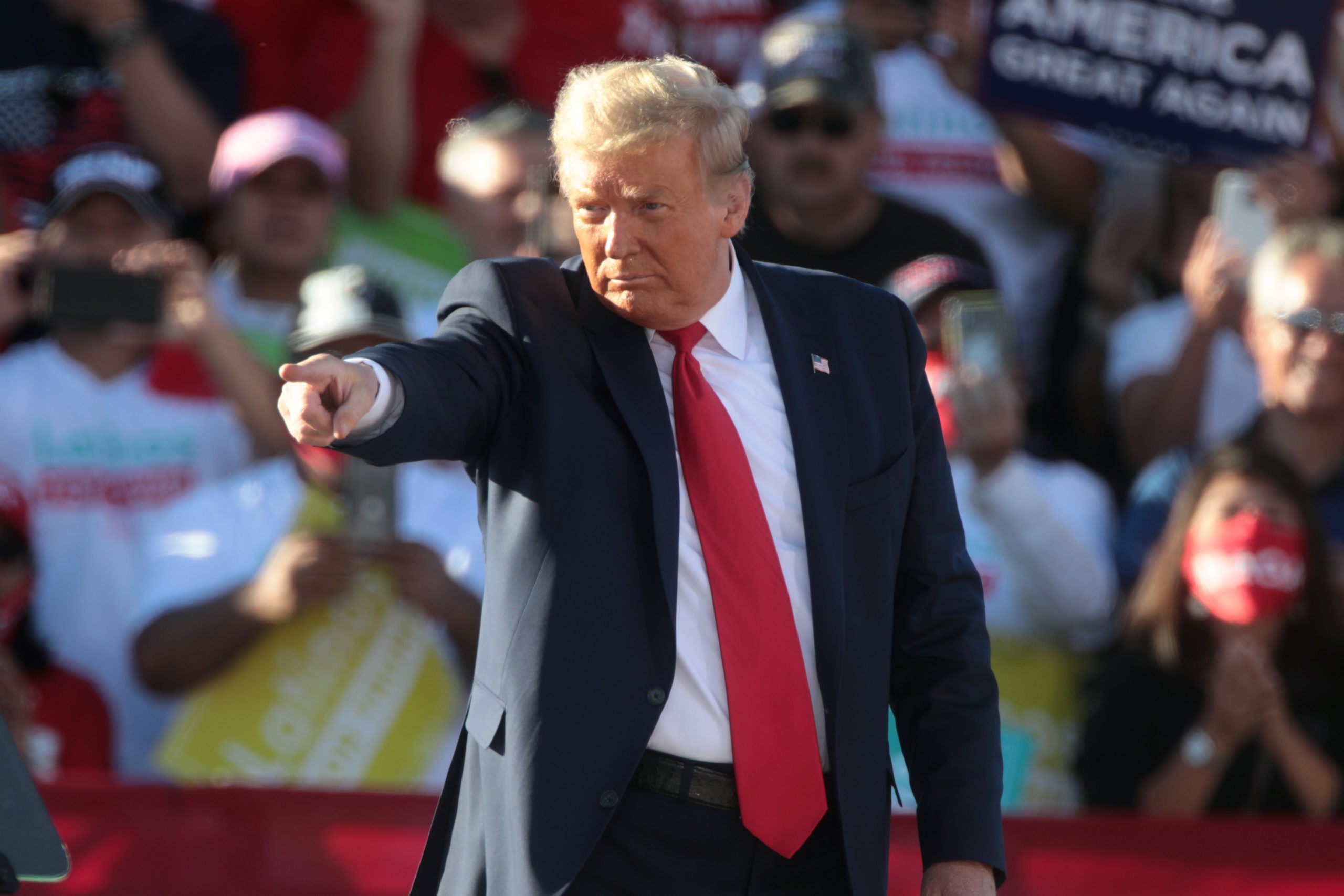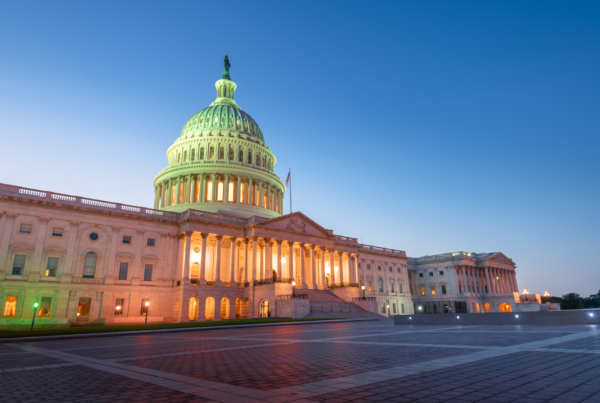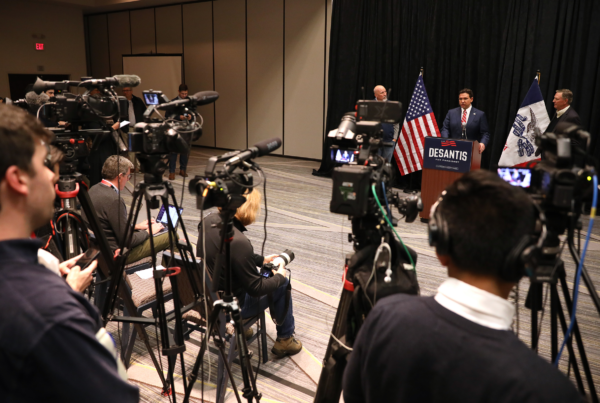Photo Gage Skidmore/Flickr
Women candidates more positive;
Democratic women laser focused on health
![]()
![]()
(MIDDLETOWN, CT) September 13, 2018 – Pro-Trump messaging in political ads continued through August. Almost 36,000 ad airings in U.S. House and U.S. Senate races mentioned Donald Trump in a positive fashion between August 1 and September 3, which is 13.4 percent of all ad airings in those races. By contrast, 4.8 percent of ads mention Trump in a negative light (Table 1).
As Figure 1 shows, this embrace of Trump is unlike past midterms. Trump has seen a greater percentage of positive mentions than any other president in the past 16 years, including George W. Bush in 2002, who was extremely popular at the time. Moreover, negative mentions of Trump are rarer than in the three previous midterm elections for the comparable time period. Only George W. Bush—less than a year after the September 11, 2001, terrorist attacks—experienced a smaller percentage of negative mentions. For comparison figures on Trump references in early summer, click here.
Figure 1: Presidential References in Congressional Midterm Advertising
![]()
Table 1: Presidential References in US House and US Senate Ads by Tone and Year
| Year | Ads with pos mention | % with pos mention | Ads with negative mention | % with negative mention | Total ads | |
|---|---|---|---|---|---|---|
| Bush | 2002 | 3,432† | 7.7% | 0† | 0.0% | 44,417† |
| Bush | 2006 | 1,211† | 1.6% | 7,621† | 9.9% | 77,283† |
| Obama | 2010 | 1,310 | 0.8% | 22,662 | 14.3% | 158,484 |
| Obama | 2014 | 145 | 0.1% | 40,510 | 24.5% | 165,646 |
| Trump | 2018 | 35,836 | 13.4% | 12,789 | 4.8% | 268,431 |
| Figures are from August 1 through September 3 for each year. Numbers include broadcast television. †Volume of ads aired in 2002 and 2006 are not comparable to later years because not all media markets were tracked. CITE SOURCE OF DATA AS: Kantar Media/CMAG with analysis by the Wesleyan Media Project. |
||||||
Table 2 shows how the tone of presidential mentions varies by party and year. Fully 26 percent of Republican ads aired in congressional races since August 1 mentioned Trump in a positive light, much higher than in previous midterms, such as 2014 and 2010, when Democrats barely mentioned Barack Obama at all. Moreover, 10 percent of Democratic ads mentioned Trump in a negative fashion, a percentage much lower than Republican negative mentions of Obama in the previous two midterms (26 percent and 49 percent).
![]()
Table 2: Tone of Presidential Mentions by Party and Year
| Year | Positive Dem | Positive Rep | Negative Dem | Negative Rep |
|---|---|---|---|---|
| 2002 | 2.2% | 15.9% | 0.0% | 0.0% |
| 2006 | 0.3% | 2.8% | 19.3% | 0.9% |
| 2010 | 1.8% | 0.0% | 0.8% | 25.6% |
| 2014 | 0.2% | 0.0% | 2.7% | 48.7% |
| 2018 | 2.1% | 26.3% | 10.3% | 0.0% |
| Figures are from August 1 through September 3 for each year. Numbers include broadcast television. CITE SOURCE OF DATA AS: Kantar Media/CMAG with analysis by the Wesleyan Media Project. |
||||
“Clearly, Republicans are “all in” when it comes to Trump in 2018, hoping that an embrace of the president will entice Republican voters to the polls,” said Erika Franklin Fowler, co-director of the Wesleyan Media Project. “Democrats, by contrast, are not using Trump as a foil to the extent that Republicans used Obama in the past. Views of Trump among Democratic voters may be so entrenched that attacking the president has little impact.”
![]()
Women Candidates Run More Positive Campaigns
Record numbers of women candidates are running for congress in 2018, and the Wesleyan Media Project is tracking differences in ads sponsored by men and women on the campaign trail.
In looking at the breakdown ad sponsors in congressional and gubernatorial campaigns by gender, 30 percent of the candidates airing ads on broadcast television are women (Table 3). This number is highest in House races, where 35 percent of the candidates airing ads were women, compared to 21 percent of gubernatorial candidates. Of the 80 women candidates in the data running as a Democrat or Republican (Terry Hayes is running for Governor of Maine as an Independent), 58 (73 percent) are Democrats.
![]()
Table 3: Number of Candidates Airing Ads by Gender and Office
| Favored candidate | Governor | House | Senate | Total |
|---|---|---|---|---|
| Women | 18 (21%) | 52 (35%) | 11 (28%) | 81 (30%) |
| Men | 66 (79%) | 98 (65%) | 28 (72%) | 192 (70%) |
| Total | 84 | 150 | 39 | 273 |
| Totals are number of congressional and gubernatorial candidates running ads from August 1, 2018 to September 3, 2018. Percents are by column. Numbers include broadcast television. CITE SOURCE OF DATA AS: Kantar/CMAG with analysis by the Wesleyan Media Project. |
||||
For the remainder of this analysis, the Wesleyan Media Project will analyze the presentation of the candidate based on the content of each creative for all candidate-sponsored ads – in other words, for each creative, WMP staff determine whether the favored candidate is identifiable as a man or a woman. In attack ads or other cases where the favored candidate is not featured, an ad would be marked as not ascertainable. Among airings where the candidate was identifiable as a man or woman, thirty-three percent of candidate airings from Democrats were sponsored by women candidates (Table 4), compared to 16 percent of candidate airings from Republicans. This is largely a reflection of the fact that more women are running for office under the Democratic label than under the Republican label.
![]()
Table 4: Candidate Airings by Gender and Party
| Women | Men | Not ascertainable | Total | ||
|---|---|---|---|---|---|
| Democrat | Airings | 56,956 | 117,004 | 3,135 | 177,429 |
| row % | 32.1% | 65.9% | 1.8% | ||
| Republican | Airings | 15,977 | 86,737 | 17,044 | 119,989 |
| row % | 13.3% | 72.3% | 14.2% | ||
| Totals are candidate-sponsored ads from congressional and gubernatorial candidates airing between August 1, 2018 and September 3, 2018. Numbers include broadcast television. Coders could not ascertain the gender of the sponsoring candidate in a small number of cases, generally in negative ads in which the sponsoring candidate is not mentioned — and in gubernatorial race ads, where the requirement for candidates to authorize their ads does not apply. These ads are omitted from the analysis. CITE SOURCE OF DATA AS: Kantar/CMAG with analysis by the Wesleyan Media Project. |
|||||
Table 5 shows the tone of ads aired by men and women, broken down by party. In both parties, women were more likely to air positive ads than were men. Among Democrats, 75 percent of ads aired by women were positive compared to 64 percent of ads aired by men. Among Republicans, 63 percent of the ads aired by women candidates were positive versus 50 percent for men candidates. Women were also less likely to attack. Among Democrats, 13 percent of ads sponsored by men contained an attack compared to 5 percent of ads sponsored by women. On the Republican side, 16 percent of ads sponsored by men contained an attack versus 14 percent of ads sponsored by women.
![]()
“These differences must be interpreted carefully,” said Travis Ridout, co-director of the Wesleyan Media Project. “It could be the straightforward case that women are less likely to engage in attack politics, but women’s tendency to be more positive may have more to do with the nature of the races in which they are competing this year. For example, new challengers need to introduce themselves to voters.”
![]()
![]()
Table 5: Candidates Airings by Gender, Party, and Tone
| Contrast | Promote | Attack | ||
|---|---|---|---|---|
| Democrat | ||||
| Men | Airings | 26,761 | 75,193 | 15,050 |
| row % | 22.9% | 64.3% | 12.9% | |
| Women | Airings | 11,273 | 42,584 | 3,099 |
| row % | 19.8% | 74.8% | 5.4% | |
| Republican | ||||
| Men | Airings | 29,089 | 43,699 | 13,949 |
| row % | 33.5% | 50.4% | 16.0% | |
| Women | Airings | 3,663 | 10,125 | 2,189 |
| row % | 22.9% | 63.4% | 13.7% | |
| Totals are candidate-sponsored ads from congressional and gubernatorial candidates airing between August 1, 2018 and September 3, 2018. Numbers include broadcast television. CITE SOURCE OF DATA AS: Kantar/CMAG with analysis by the Wesleyan Media Project. |
||||
Gender of Candidate Influences Trump Mentions Among Democrats
In Table 6, we look at the number of mentions (in both an approving or disapproving way) of both Donald Trump and Nancy Pelosi by party and by men and women candidates. Notably, there were zero mentions of Nancy Pelosi in an approving way, and a small number of mentions of her in a disapproving way in both parties (though more frequently from Republicans).
The gender of the candidate has little impact on mentions of Trump or Pelosi among Republicans. About 21 percent of ads sponsored by Republican candidates—regardless of whether they are men or women—mention Trump in a positive way. And about 5 percent of Republican ads mention Pelosi in a negative way—again regardless of the gender of the candidate.
But on the Democratic side, the gender of the candidate appears to condition mentions of Trump. While 26 percent of ads aired by Democratic men mention Trump in a negative fashion, only 13 percent of ads aired by Democratic women mention Trump negatively.
![]()
“Women candidates running as Republicans are not averse to embracing Trump,” said Michael Franz, co-director of the Wesleyan Media Project. “It is also noteworthy that Democratic women are not more explicitly running against Trump, given his known comments about women and the recent admission from Michael Cohen about Trump’s knowledge of payments to Stormy Daniels.”
![]()
![]()
Table 6: Candidates Airings by Gender, Party, and Trump/Pelosi Mentions
| Approval of Trump | Disapproval | Approval of Pelosi | Disapproval | ||
|---|---|---|---|---|---|
| Democrat | |||||
| Men | Airings | 3,133 | 30,612 | 0 | 926 |
| % | 2.7% | 26.2% | 0 | 0.8% | |
| Women | Airings | 564 | 7,268 | 0 | 803 |
| % | 1.0% | 12.8% | 0 | 1.4% | |
| Republican | |||||
| Men | Airings | 18,230 | 6 | 0 | 3,997 |
| % | 21.0% | 0.01% | 0 | 4.6% | |
| Women | Airings | 3,389 | 0 | 0 | 903 |
| % | 21.2% | 0 | 0 | 5.7% | |
| Totals are candidate-sponsored ads from congressional and gubernatorial candidates airing between August 1, 2018 and September 3, 2018. Numbers include broadcast television. CITE SOURCE OF DATA AS: Kantar/CMAG with analysis by the Wesleyan Media Project. |
|||||
Mentions of Health Care, Taxes Vary by Gender of Candidate
Our final analysis examines issue mentions in ads. Table 7 shows the number of mentions of key issues the Wesleyan Media Project has been tracking in our issue spotlights throughout the summer by party and gender of candidate between August 1 and Labor Day.
On the Democratic side, women candidates mentioned health care in half of their ads, far outpacing any other issue mention. Democratic men mentioned health care in about 1 in 3 ads. Democratic men were more likely to mention the issues of taxes, jobs and immigration than Democratic women. On the Republican side, men were more likely to mention health care and taxes than women candidates, but there was no differences in the likelihood of mentioning immigration or jobs.
![]()
Table 7: Candidate Airings by Gender, Party, and Selected Issue Mentions
| Health care | Taxes | Jobs | Immigration | ||
|---|---|---|---|---|---|
| Democrats | |||||
| Men | Airings | 39,529 | 16,088 | 21,690 | 13,156 |
| % | 33.8% | 13.8% | 18.5% | 11.2% | |
| Women | Airings | 28,344 | 3,612 | 5,508 | 1,356 |
| % | 49.8% | 6.4% | 9.7% | 2.38 | |
| Republicans | |||||
| Men | Airings | 14,613 | 31,379 | 19,473 | 20,693 |
| % | 16.9% | 36.2% | 22.5% | 23.9% | |
| Women | Airings | 385 | 3,891 | 3,555 | 3,746 |
| % | 2.4% | 24.4% | 22.3% | 23.5% | |
| Totals are candidate-sponsored ads from congressional and gubernatorial candidates airing between August 1, 2018 and September 3, 2018. Numbers include broadcast television. CITE SOURCE OF DATA AS: Kantar/CMAG with analysis by the Wesleyan Media Project. |
|||||
Men Talk Education, Budget and Corruption More Than Women
Table 8 shows the number of issue mentions by candidate gender and party for five additional issues. Men were more likely to mention education, the budget and corruption than were women candidates—a finding that holds across the parties. On guns, the issue was slightly more prevalent among Democratic men than women, but the reverse was true for Republicans.
![]()
Table 8: Candidate Airings by Gender and Selected Issue Mentions
| Education | Guns | Budget | Social Security | Corruption | ||
|---|---|---|---|---|---|---|
| Democrat | ||||||
| Men | Airings | 36,154 | 17,513 | 14,929 | 7,327 | 8,496 |
| % | 30.9% | 15.0% | 12.8% | 6.3% | 7.3% | |
| Women | Airings | 11,058 | 7,057 | 3,045 | 3,556 | 1,858 |
| % | 19.4% | 12.4% | 5.4% | 6.2% | 3.3% | |
| Republican | ||||||
| Men | Airings | 16,017 | 2,666 | 14,627 | 2,379 | 14,026 |
| % | 18.5% | 3.1% | 16.9% | 2.7% | 16.2% | |
| Women | Airings | 981 | 1,047 | 1,667 | 113 | 1,243 |
| % | 6.1% | 6.6%% | 10.4% | 0.7% | 7.8% | |
| Totals are candidate-sponsored ads from congressional and gubernatorial candidates airing between August 1, 2018 and September 3, 2018. Numbers include broadcast television. CITE SOURCE OF DATA AS: Kantar/CMAG with analysis by the Wesleyan Media Project. |
||||||
About This Report
Data reported here from Kantar Media/CMAG do not cover local cable buys, only broadcast television, national network and national cable buys.
The Wesleyan Media Project (WMP) provides real-time tracking and analysis of political advertising in an effort to increase transparency in elections. Housed in Wesleyan’s Quantitative Analysis Center – part of the Allbritton Center for the Study of Public Life – the Wesleyan Media Project is the successor to the Wisconsin Advertising Project, which disbanded in 2009. It is directed by Erika Franklin Fowler, associate professor of government at Wesleyan University, Michael M. Franz, professor of government at Bowdoin College and Travis N. Ridout, professor of political science at Washington State University. WMP staff include Laura Baum (Project Manager), Dolly Haddad (Project Coordinator) and Matthew Motta (Research Associate).
The Wesleyan Media Project is supported by Wesleyan University and the John S. and James L. Knight Foundation. Data are provided by Kantar Media/CMAG with analysis by the Wesleyan Media Project. WMP is partnering again this year with the Center for Responsive Politics, to provide added information on outside group disclosure.
Periodic releases of data will be posted on the project’s website and dispersed via Twitter @wesmediaproject. To be added to our email update list, click here.
For more information contact:
mediaproject@wesleyan.edu
About Wesleyan University
Wesleyan University, in Middletown, Conn., is known for the excellence of its academic and co-curricular programs. With more than 2,900 undergraduates and 200 graduate students, Wesleyan is dedicated to providing a liberal arts education characterized by boldness, rigor and practical idealism. For more, visit wesleyan.edu.
About the John S. and James L. Knight Foundation
Knight Foundation is a national foundation with strong local roots. We invest in journalism, in the arts, and in the success of cities where brothers John S. and James L. Knight once published newspapers. Our goal is to foster informed and engaged communities, which we believe are essential for a healthy democracy.





